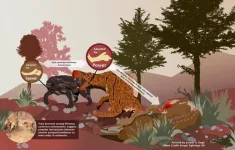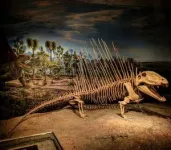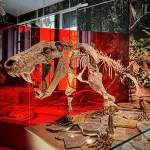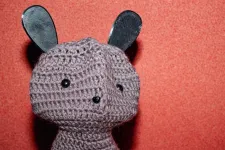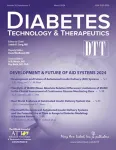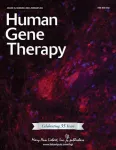(Press-News.org) The evolutionary success of the first large predators on land was driven by their need to improve as killers, researchers at the University of Bristol and the Open University suggest.
The forerunners of mammals ruled the Earth for about 60 million years, long before the origin of the first dinosaurs. They diversified as the top predators on land between 315–251 million years ago.
Researchers studied the jaw anatomy and body size of carnivorous synapsids, using these traits to reconstruct the likely feeding habits of these ancient predators and chart their ecological evolution through time. They found a major shift in synapsid jaw function roughly 270 million years ago linked to a significant shift in predatory behaviour that has important implications for the evolution of our earliest ancestors.
As herbivores grew larger and faster, carnivores adapted to become bigger and better predators to survive.
“Earlier synapsid predators such as the famous sail backed Dimetrodon, had fairly long jaws with lots of teeth to ensure that once they ensnared their prey, it wouldn’t escape,” explained lead author Dr Suresh Singh based in Bristol’s School of Earth Sciences. “However, we saw a shift in jaw function toward shorter jaws with greater muscle efficiency and fewer teeth that were concentrated at the front of the jaw - these were jaws adapted to deliver deep, powerful bites.
“The change shows that later synapsid carnivores placed more emphasis on heavily injuring and so more quickly killing their prey. Among these later synapsids were the very first sabertoothed carnivores! This change highlights that predators were facing new selective pressures from their prey.”
This finding provides important context for a key step in synapsid evolution. “The reorganisation of synapsid jaws through this time has long been known as a big step towards the evolution of mammals,” added Dr Armin Elsler, a collaborator on the study. “These changes don’t just make the jaw more efficient; they also mark the very earliest redevelopment of the jaw that also created the complex ear found in mammals. What drove this first step? Our study suggests that it was partly driven by ecological pressures from their prey.”
Co-author Dr Tom Stubbs said: “The timing of the shift in jaw function corresponds with the evolution of new larger, faster herbivores that would have posed a greater challenge for predators to tackle.
“The risks to carnivores of getting injured or killed went up, so some synapsid carnivores became bigger, better killers to overcome these risks.”
This shift reflects a new dynamism in predator-prey interactions that shows that life on land was moving more quickly.
“The late Palaeozoic was the time when animals first began to live, eat and reproduce entirely on land,” said Professor Mike Benton, a co-supervisor on the study
“They became fully terrestrial, colonising new habitats and exploiting new resources further inland from the aquatic environments they’d previously relied on.
“Our findings show how the selective pressures on these early land animals changed as they became better adapted for life on land - catching another animal that can move fast and grow to larger sizes is much more difficult than catching a slippery little fish or amphibian.”
Professor Emily Rayfield also co-supervised the study. She added: “Predator-prey interactions are an important driver of animal behaviour today so it’s quite something to see that influence through anatomical evolution over millions of years, and find that they are potentially responsible for driving some big leaps in our own evolutionary history.
“It highlights how palaeontologists can use the relationship between form and function to explore how different prehistoric animals may have lived, which can tell us so much about the evolution of life on Earth.”
The researchers also found that synapsid carnivore morphological diversity increased following the shift, with the addition of new functional groups adapted for either faster biting speeds or even more powerful bites through the mid-late Permian – around 265-251 million years ago. By assessing how the sizes of these new carnivore species compared within different communities through time, they realised these communities may have begun to closely resemble those of modern carnivorous mammals.
The paper:
'Predatory synapsid ecomorphology signals growing dynamism of late Palaeozoic terrestrial ecosystems' by S.A Singh, A Elsler, T.L Stubbs, Mike Benton et al in Communications Biology, 201 (2024). https://doi.org/10.1038/s42003-024-05879-2.
END
Killer instinct drove evolution of mammals’ predatory ancestors
2024-02-23
ELSE PRESS RELEASES FROM THIS DATE:
Diversifying data to beat bias
2024-02-23
AI holds the potential to revolutionize healthcare, but it also brings with it a significant challenge: bias. For instance, a dermatologist might use an AI-driven system to help identify suspicious moles. But what if the machine learning model was trained primarily on image data from lighter skin tones, and misses a common form of skin cancer on a darker-skinned patient?
This is a real-world problem. In 2021, researchers found that free image databases that could be used to train AI systems to diagnose skin cancer contain very few images ...
Increased use of Paxlovid could cut hospitalizations, deaths and costs
2024-02-23
Increased use of Paxlovid, the antiviral drug used to treat COVID-19, could prevent hundreds of thousands of hospitalizations and save tens of billions of dollars a year, according to a new epidemiological model published by researchers at The University of Texas at Austin. In fact, epidemiologists found that treating even 20% of symptomatic cases would save lives and improve public health.
A 2023 National Institutes of Health study found that only about 15% of high-risk patients take Paxlovid when infected with COVID-19. Using a multiscale mathematical model based on ...
How to build your own robot friend: Making AI education more accessible
2024-02-23
From smart virtual assistants and self-driving cars to digital health and fraud prevention systems, AI technology is transforming almost every aspect of our daily lives—and education is no different. For all its promise, the rise of AI, like any new technology, raises some pressing ethical and equity questions.
How can we ensure that such a powerful tool can be accessed by all students regardless of background?
Inspired by this call to action, USC researchers have created a low-cost, accessible learning kit to help college and high school students build their own “robot friend.” Students can personalize the robot’s ...
Advances and future development of automated insulin delivery systems
2024-02-23
A special 13-article supplement to the peer-reviewed journal Diabetes Technology & Therapeutics (DTT) examines the “Development and Future of Automated Insulin Delivery (AID) Systems. Click here to read the supplement now.
Included in the supplement is the article titled “A Peek Under the Hood: Explaining the MiniMed™ 780G Algorithm with Meal Detection™ Technology", by Benyamin Grosman, PhD and his Medtronic algorithm team with co-authors Ohad Cohen, MD, and Robert Vigersky, MD, Chief Medical Officer at Medtronic. James Thrasher, MD “Early ...
Strategic grazing could boost conservation of ‘near-threatened’ sage-grouse
2024-02-23
RENO, Nev. – A multi-agency study, spearheaded by researchers from the University of Nevada, Reno’s College of Agriculture, Biotechnology & Natural Resources and the U.S. Department of Agriculture, underscores the impacts of strategic cattle grazing, particularly on restoring the declining population of the greater sage-grouse bird, a keystone species in the Great Basin region.
Amidst ongoing decline, the U.S. Fish and Wildlife Service acted by listing the sage-grouse for protection under the Endangered Species Act in 2011. This move prompted the Bureau of Land Management to develop a federal conservation plan for the species ...
Complement system response to AAV vector gene therapy
2024-02-23
Recent clinical trials utilizing high doses of adeno-associated virus (AAV) vectors have highlighted a new challenge to AAV gene transfer – activation of the complement system. A new article in the peer-reviewed journal Human Gene Therapy describes how a convergence of AAV-specific, environmental, and patient-specific factors shaping complement responses likely contribute to differential outcomes seen in clinical trials. Click here to read the article now.
Complement responses may contribute to priming of the adaptive immune system or serious adverse events ...
Study suggests people in urban areas with more green space have better mental health
2024-02-23
By Ann Kellett, Texas A&M University School of Public Health
A new study from the Texas A&M University School of Public Health suggests that city dwellers who have more exposure to urban green spaces require fewer mental health services.
The study, published in the International Journal of Environmental Research and Public Health, was conducted by Jay Maddock, Ph.D., Regents Professor of environmental and occupational health at Texas A&M, and colleagues from the Center ...
Zinc discovery holds promise for people with cystic fibrosis
2024-02-23
University of Queensland researchers have identified an opportunity to reduce infections in people living with cystic fibrosis.
Professor Matt Sweet, Dr Kaustav Das Gupta and Dr James Curson from UQ’s Institute for Molecular Bioscience have discovered a fault in the bacteria-killing function of immune cells in people with CF and a potential way to get around it.
CF is a chronic disease in which defects in the CFTR (cystic fibrosis transmembrane conductance regulator) channel cause a build-up of mucus in the lungs, airways and digestive system, leading to ...
Study finds black children in UK at four times greater risk of complications following emergency appendicitis surgery compared with white children
2024-02-23
New research published in Anaesthesia (the journal of the Association of Anaesthetists) shows that for children undergoing emergency surgery for appendicitis in the UK, black children had a four times greater risk of postoperative complications compared with white children. The study was led by Dr Amaki Sogbodjor, from Great Ormond Street Hospital and University College London (UCL), and Professor Ramani Moonesinghe, UCL Division of Surgery and Interventional Science, London, UK and Director, Central London National ...
Webb finds evidence for neutron star at heart of young supernova remnant
2024-02-22
NASA’s James Webb Space Telescope has found the best evidence yet for emission from a neutron star at the site of a recently observed supernova. The supernova, known as SN 1987A, was a core-collapse supernova, meaning the compacted remains at its core formed either a neutron star or a black hole. Evidence for such a compact object has long been sought, and while indirect evidence for the presence of a neutron star has previously been found, this is the first time that the effects of high-energy ...
